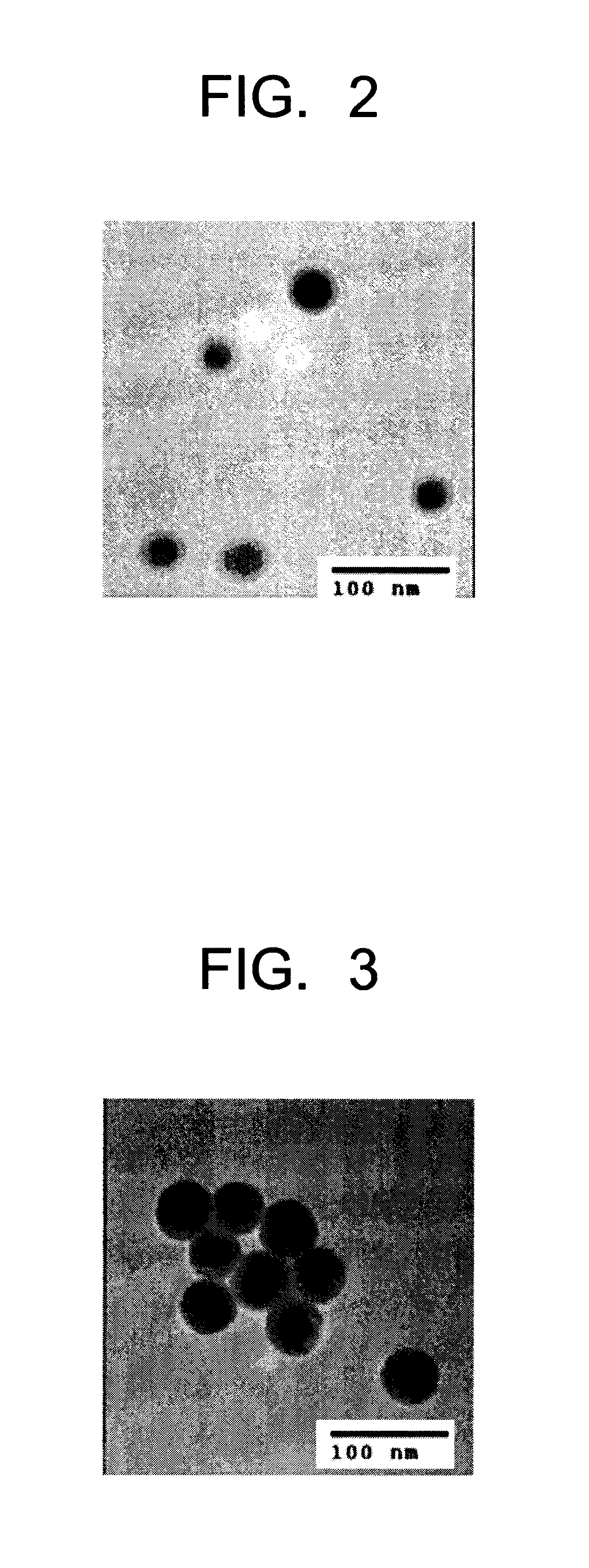Process for production of surface-coated inorganic particles
a technology of inorganic particles and surface coatings, which is applied in the direction of magnetic bodies, magnetic paints, instruments, etc., can solve the problems of nano-sized particles synthesized, nano-sized particles covered with dimercaptosuccine acid surface coatings, and chemical unstability problems
- Summary
- Abstract
- Description
- Claims
- Application Information
AI Technical Summary
Benefits of technology
Problems solved by technology
Method used
Image
Examples
example 1
Use of Thiomalic Acid as Temporal Covering Material
[0060]First, 5 ml or more of 2-propanol (made by Kishida Chemical Co. Ltd.) was added into 180 mg of octadecene suspension containing oleic acid covering ferrite particles with an average diameter of about 8 nm which are finely controlled in particle diameter to aggregate the ferrite particles. Then, the ferrite particles were magnetically recovered so that the supernatant liquid was disposed. The above-described process was repeated three times using 10 ml of 2-propanol. The octadecene suspension containing the oleic acid covering ferrite particles was obtained as follows. Namely, iron chloride was reacted with sodium oleic acid to prepare iron-oleic acid complex salt, which was mixed with oleic acid and solved in octadecene at room temperature. Then, the thus obtained solution was heated to 320° C. for 90 minutes and reacted at the same temperature for 30 minutes, and cooled down to room temperature.
[0061]The 2-propanol was remove...
example 2
Use of 1-amino-8-naphtol-3,6-sodium Disulfonate as Temporal Covering Material
[0067]The surface covering for the ferrite particles was conducted in the same manner as Example 1 to obtain the citric acid covering ferrite particle dispersion solution except that 0.737 g of 1-amino-8-naphtol-3,6-sodium disulfonate (made by TOKYO CHEMICAL INDUSTRY CO., LTD., Mw=341.29) was employed as the temporal covering material.
[0068]When the diameters in water of the ferrite particles in the dispersion solution using the 1-amino-8-naphtol-3,6-sodium disulfonate as the temporal covering material were measured by dynamic light scattering method, the diameters in water fell within a range of 8.0±0.9 nm. Moreover, when the ferrite particles were observed by transmission electron microscope (TEM) so as to measure the average diameter thereof, the average diameter of the ferrite particles was about 8 nm. The particle weight distribution of the ferrite particle dispersion solution became maximum around 8 n...
example 3
Use of meso-2,3-dimercaptosuccinic Acid as Temporal Covering Material
[0069]The surface covering for the ferrite particles was conducted in the same manner as Example 1 obtain the citric acid covering ferrite particle dispersion solution except that 0.394 g of meso-2,3-dimercaptosuccinic acid (made by TOKYO CHEMICAL INDUSTRY CO., LTD., Mw=182.22) was employed as the temporal covering material. The dispersion solution of the ferrite particles covered with the meso-2,3-dimercaptosuccinic acid was colored and the iron ions of the ferrite particles were partially solved in the dispersion solution.
[0070]When the diameters in water of the ferrite particles in the dispersion solution using the meso-2,3-dimercaptosuccinic acid as the temporal covering material were measured by dynamic light scattering method, the diameters in water fell within a range of 9.0±4.6 nm. Moreover, when the ferrite particles were observed by transmission electron microscope (TEM) so as to measure the average diame...
PUM
| Property | Measurement | Unit |
|---|---|---|
| diameter | aaaaa | aaaaa |
| particle diameter distribution | aaaaa | aaaaa |
| sizes | aaaaa | aaaaa |
Abstract
Description
Claims
Application Information
 Login to View More
Login to View More - R&D
- Intellectual Property
- Life Sciences
- Materials
- Tech Scout
- Unparalleled Data Quality
- Higher Quality Content
- 60% Fewer Hallucinations
Browse by: Latest US Patents, China's latest patents, Technical Efficacy Thesaurus, Application Domain, Technology Topic, Popular Technical Reports.
© 2025 PatSnap. All rights reserved.Legal|Privacy policy|Modern Slavery Act Transparency Statement|Sitemap|About US| Contact US: help@patsnap.com



